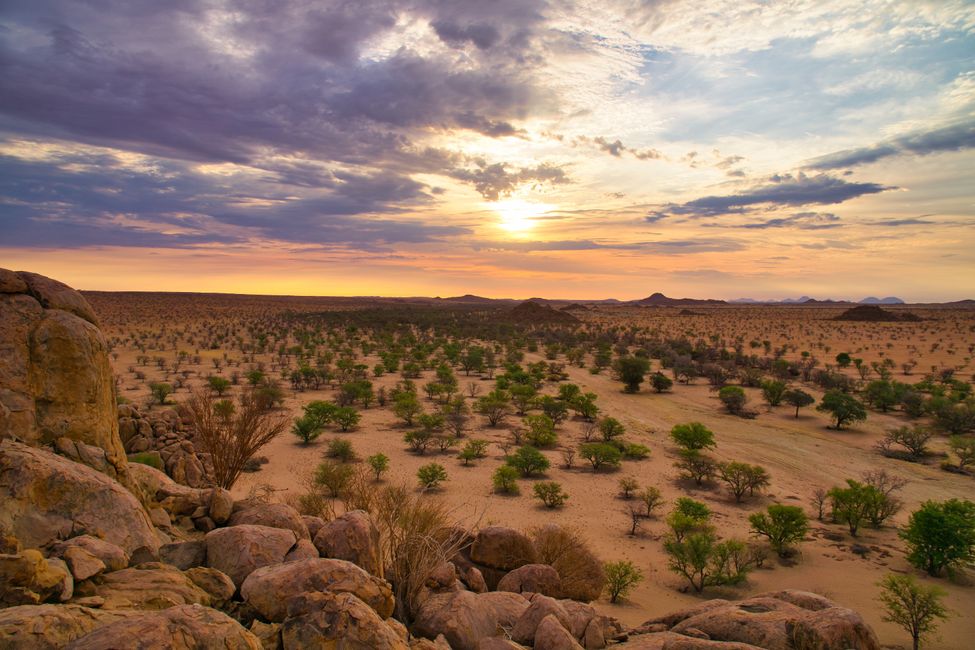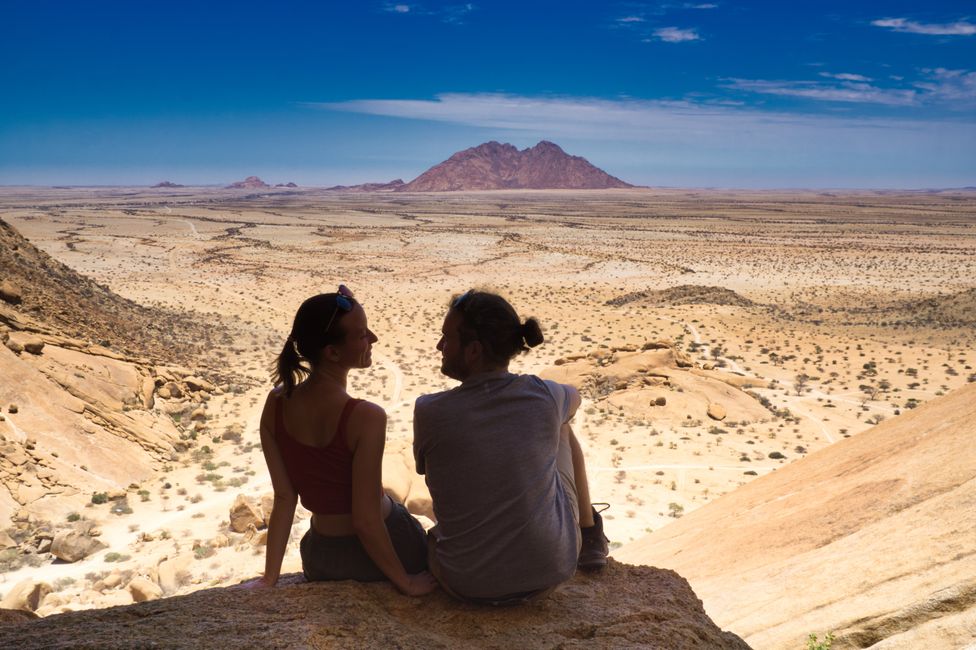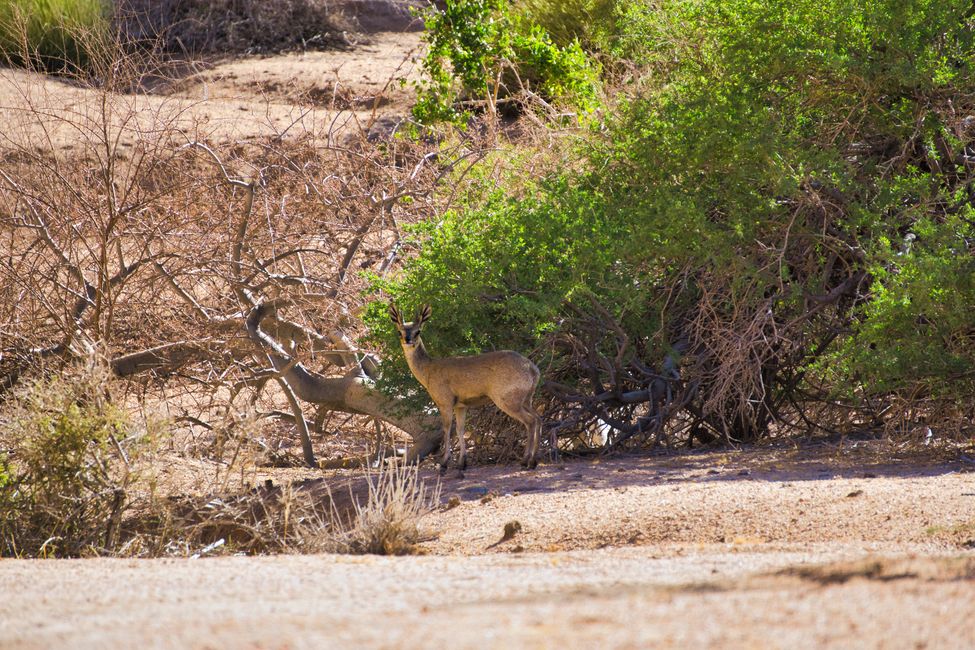The Erongo Region - Part 2
उजवाडाक आयलां: 24.11.2021


















खबरांपत्राची सदस्यताय घेयात
Omaruru
The road from the Erongo Plateau to the north towards the original Damaraland takes us through the small town of Omaruru. Although Damaraland officially belongs to the Erongo region, it is an area that dates back to the apartheid era and is named after the Damara people who live in this area.
Before we treat ourselves to a leisurely lunch in Omaruru, we need to replenish our supplies and fresh vegetables. So we drive to the supermarket on the main road and park our car. As a precaution, we have stored all our luggage in the loading area of the pick-up truck. To prevent the windows from being smashed by thieves, we have cleared the back seat and locked the suitcases and backpacks in the trunk. If there is no luggage or potential stolen goods visible, the probability of theft is supposed to be reduced. At least that's what our car rental company advised us. So with a tidy car, we park at Spar in Omaruru and are directed to parking spaces by men wearing high-vis vests. Although they are probably not employed by the supermarket, it seems to be profitable for them to wait for tourists and hope for a small reward for their unnecessary services. After we have stocked up on fresh food and also bought some barbecue food, the young men take our shopping carts away without being asked. To avoid complications, we give a few Rand to one of them and drive off.
Refuelling in Africa
After our stop in Omaruru, we get back into our car with full stomachs. We still need to refuel before we drive from Omaruru to the unknown Damaraland. In addition to a regular 80-litre tank, our pick-up has an additional 60-litre tank, so that longer journeys without refuelling opportunities are possible. We have used this additional tank in the last 500 kilometres. Since we can only refuel with absolute certainty in five days on the coast - in Swakopmund - and do not want to risk getting stranded on the way, we have the tank completely filled. That is one of the most important lessons we have been advised to follow on our journey: use every petrol station along the way. Sometimes you drive for hundreds of kilometres through vast steppe landscapes where there is not even the slightest sign of civilisation. It is not desirable to get stuck here because of an empty tank.
The friendly young petrol station employee quickly asks how much fuel we want and hangs the fuel nozzle in our tank. He probably sees at first glance that we want to fill up and need diesel for our four-wheel drive vehicle. The first refuelling is still a bit unfamiliar to us, although it doesn't go any differently than on our last trip. In contrast to at home, you literally just get serviced. After stopping at the petrol station, a - so far always male and young - employee comes directly who takes care of the refuelling. You also don't have to get out to pay, which is not a bad thing in some larger cities as a tourist so that you are not immediately besieged by street vendors. So we simply hand our credit card out of the car window into the card reader, thank the young man with a few Rand and continue driving.
Omaruru is not particularly large and apart from residential areas - if you can call them that - and extensive farm areas, it consists of a main road where you can find not only petrol stations, but also a few shops, butchers, a bank and a supermarket. After the first turn, we are already out of town and driving on a gravel road.
Damaraland
After two hours of driving, we reach our next campsite, the Madisa Camp. It is located directly on a dried-up riverbed where desert elephants are said to live. At least that's what our research before the trip revealed. In order to be able to peacefully observe the large gray mammals, we have booked two nights here.
Unfortunately, the owner of the camp immediately dispels our illusions. Although the camp offers elephant drives, i.e. half-day trips in a safari car, they are not available on the days we are here. That's not a problem as we prefer to be independent, to remain flexible and to save our budget a little. So we ask where we have to go to see the elephants. The man points towards the riverbed: "You have to drive there, but it's not easy. We can't tow you and many people have already been stranded in the sandy riverbed." What a shame. We don't want to get stuck in the sand and we are also not allowed to drive our car into riverbeds for a reason. We think it probably wasn't without reason that our car rental company has specified this in the contract. We think it over and decide to just have a relaxed day by the pool. Our next campsite, the Brandberg White Lady Lodge, also offers elephant drives. Hopefully, we will still have the opportunity to observe these beautiful animals there.
Our Routine
We approach today with a completely relaxed attitude. For the first time, we don't have to set up our roof tent. Although it doesn't take much effort, it's nice to be able to leave everything as it is. By now, we have developed a small routine, even though we haven't been on the road for a whole week yet. We wake up shortly after six o'clock in the morning, when it is slowly getting light. To let air in through the mosquito nets and to avoid sweating, we usually leave the sides of the roof tent open. This way, we also wake up immediately when it starts to get light. Or we are already awakened earlier by incredibly loud birds. A dove-like bird makes a really strange sound that sounds like "Bäh". For ornithologists, Namibia must be a true paradise. It's a pity that we don't know anything about birds in this respect. We didn't even bring a bird guide with us.
When we are awake, Maxi gets up, boils water, and pours coffee in our French press. Without coffee, he probably wouldn't survive an hour. I take a more relaxed approach, usually read a bit more, and let myself be lured out of the roof tent by the scent of fresh coffee at some point. Actually, I already prepare everything for dismantling, fold the mattress together and take my books, water bottle and clothes with me downstairs. Today, none of this is necessary since we are staying here for another night. We leisurely drink our coffee, Maxi with cow's milk, me with the oat milk I found in Windhoek.
We grab our towels and spend the day at the small, shady pool. Time seems to stand still here, and you could probably spend days here without wanting to leave. The surroundings are beautiful, with barren landscapes and isolated trees and bushes, but also these crazy heaps of rocks that sometimes turn into real mountains. At the pool, we lie on the comfortable pallet loungers, occasionally jump into the cool water, and spend our time reading, writing, and planning the rest of our route. Time flies by quickly, and we enjoy just doing nothing.
In the afternoon, we walk back to our spot and already prepare everything for our planned braai. In southern Africa, people do not grill on expensive gas or electric grills like in Germany, but with a simple grill grate on a fire pit. There is also no barbecue, no, here it is called braai, and you don't hear anything else. In Omaruru, we bought some barbecue food, which we now spread on the grill grate. We also chop a bell pepper and mushrooms and put a garlic bread in aluminum foil directly in the fire. Together with the typical Namibian chutney and a garlic mayonnaise, it makes a delicious meal, our first real braai.
After the braai, we hurry to be able to watch the sunset from the rocks. Equipped with two Savanna ciders and camera equipment, we climb higher and higher over the rocks. About twenty minutes later, slightly sweaty, we stand on the highest rock, where a small French tour group has already settled. We choose a rock next to them, jump over and position ourselves facing the sun, which is still slightly above the horizon. Relaxed, we wait with the sundowner for the sunset and take pictures of the beautiful landscape. From up here, you can see a section of the riverbed and in another direction the huge Brandberg, where we will go tomorrow.
The solemn mood is slightly disrupted by a group of loud French people, but we continue to enjoy the intense shades of red of the sky that change depending on the position of the sun.
"Banana, Potatoe, Spaghetti, Maccaroni!", we hear them shout as the African tour guide takes the last group photo of the elderly ladies and gentlemen before they dare to descent. But I don't know if we would really feel comfortable in such groups. We prefer to travel independently, can plan the route ourselves, change our plans flexibly without having to accommodate a group of people. It is easier to travel as a couple, although we have collected ideas separately, we have made joint decisions regarding campsites, route, and activities. It probably helps that we have known each other for so long and have lived together for many years. We are fully familiar with each other, know our habits, and have now harmonized them with each other. There is no longer any shyness or polite consideration like with strangers in our relationship. If one of us wants something or not, we address it directly and can openly agree on it. Without such familiarity, you probably wouldn't survive a multi-month trip.
We silently enjoy the last minutes of the setting sun and make our way back to use the last daylight for the descent over the smooth, steep rocks.
Brandberg
The next section of our route takes us back a bit to the south to Brandberg, Namibia's highest mountain at 2573 meters. The Brandberg Massif is not only a spectacular landscape, but also home to numerous millennia-old cave paintings - about 50,000! - including the White Lady. This white lady actually represents an African, dark-skinned warrior, but was mistaken for a white lady by the first discoverer Reinhard Maack. Since then, the name has stuck. Our next accommodation, the Brandberg White Lady Lodge, is named after this White Lady. We deliberately chose it because it is located on the banks of the Ugab River and is known for the regular presence of elephants walking through the campsite or at least being nearby. That's exactly what we hope for during our stay here.
The drive is even more adventurous than usual. First, we drive on the familiar gravel roads, but after reaching the Ugab River, the last 20 kilometres are guided along the riverbank to the lodge by our navigation app. On the map, you can see a road, but when we look out of the windshield, you can see rather little. With great difficulty, a small path can be made out in the sandy terrain, which we cautiously follow over the rocky ground. It's not far now, it will be fine.
At some point on such routes, which already seem adventurous at the beginning and become worse and worse over time, you reach a 'point of no return'. Then you have already driven so far and over so many bad spots that you can no longer turn around and take a different route. Apart from that, it would have been almost impossible to turn our huge off-road vehicle between the rocks. So we grit our teeth and hope it doesn't get any worse. And hope that we don't get stuck with the big rocks that we slowly struggle forward over and cause major damage. It's quite a nerve-racking experience.
Shaken, we finally reach our next campsite and choose a spot directly on the riverbank to not miss any passing elephants. Unfortunately, we don't have any luck today, so we book an elephant drive for the next day, a ride with a guide through the riverbed. We are not the only ones with this idea, so the next morning at 8 o'clock, we sit in an open truck converted into a safari car with ten French people and are shaken over similar adventurous routes as yesterday on our way to the campsite. Seat belts? Not available. What you won't do for a few elephants.
Together with our giggling fellow travellers, we finally reach the riverbed after an hour of driving over rocks and stones. The riverbed seems to form a green, narrow oasis in the barren steppe landscape. In the background, there is a breathtaking view of the massive Brandberg, but no sign of elephants. But our guide seems to know exactly what he is doing and continues to fight his way through the sandy terrain with the safari car. And indeed: after the next bend, we suddenly spot them! Several large gray animals are standing casually at the edge of the riverbed and feeding on the leaves and branches of the trees. Between the bushes and trees, there are more elephants hidden who are not bothered by us at all. We all stare at the huge, fascinating animals captivated. No one dares to say anything and destroy the atmosphere. Safari truly has something magical.
The so-called desert elephants are slimmer than their counterparts, have longer legs and larger feet so that they can wander further and without sinking into the sandy desert. A desert elephant covers about 70 kilometres daily in search of food and has managed to adapt to desert conditions relatively quickly.
After a while, we leave the elephants in peace to continue feeding and enjoy the fact that we have come so close to them in the wild, in their natural environment.
Spitzkoppe
The next stage takes us back to mountainous terrain. The Spitzkoppe is not extremely high at 1728 meters, but it consists of huge reddish rock blocks that together form a very special but beautiful mountain - the so-called 'Matterhorn of Namibia'. Here, too, there are numerous rock paintings, which, unlike Philip's Cave in the Erongo Mountains, can only be explored with a guide to prevent vandalism.
Our campsite, the Spitzkoppe Community Rest Camp, offers huge pitches with kilometres between them all the way around the entire mountain, so that it feels as if you have the entire mountain to yourself. We choose the spot where we camped on our last trip here and position ourselves directly on the slope of the koppe. Apart from a barbecue and fire pit and a modern outhouse, there is actually nothing here. No electricity, no water, no WiFi, you have to live completely self-sufficiently for the duration of your stay. If you want to shower or wash dishes, you have to drive a few kilometres back to the reception. We were prepared for that and filled several canisters with water. Fortunately, our cooler box can run for two days without electricity.
On the next day, we set out for a small hike. At the top of the mountain, we discovered a fissure that we want to climb up to. Equipped with plenty of water, snacks, sunscreen and a hat, we scramble up. While the first meters still feel like a rocky hike, the second half is a real climb that we were not prepared for. Nevertheless, we trust in the profile of our hiking shoes and continue upwards. In contrast to our previous hikes through the Black Forest, where we also managed a whole day of brisk hiking relatively well, we quickly run out of breath here in the scorching heat. The 'path' does not provide shade, so we take every opportunity to briefly drink something in the shade under a larger rock. The last twenty meters up to the fissure are just a smooth, quite steep rock face which we pull ourselves up slowly to avoid slipping. Since we both have no climbing experience, it probably looks pretty awkward, but we are relieved when we finally reach the top. The view from above is even more breathtaking than it already was - from the Spitzkoppe you can see the so-called 'Sugarloaf', a similarly shaped mountain - and we enjoy our well-deserved break in the shade before we start our way back down.
खबरांपत्राची सदस्यताय घेयात
जाप

प्रवास अहवाल नामिबिया

